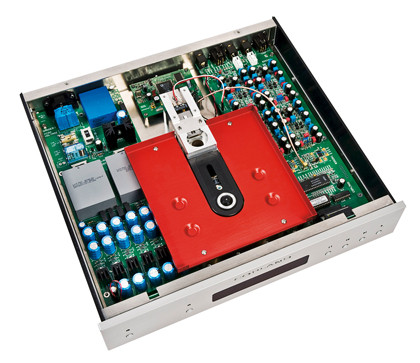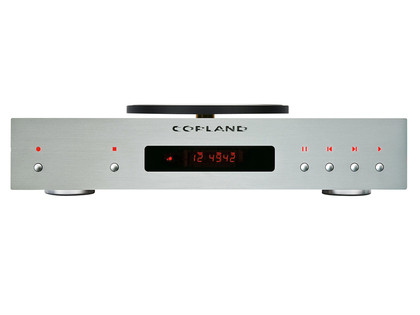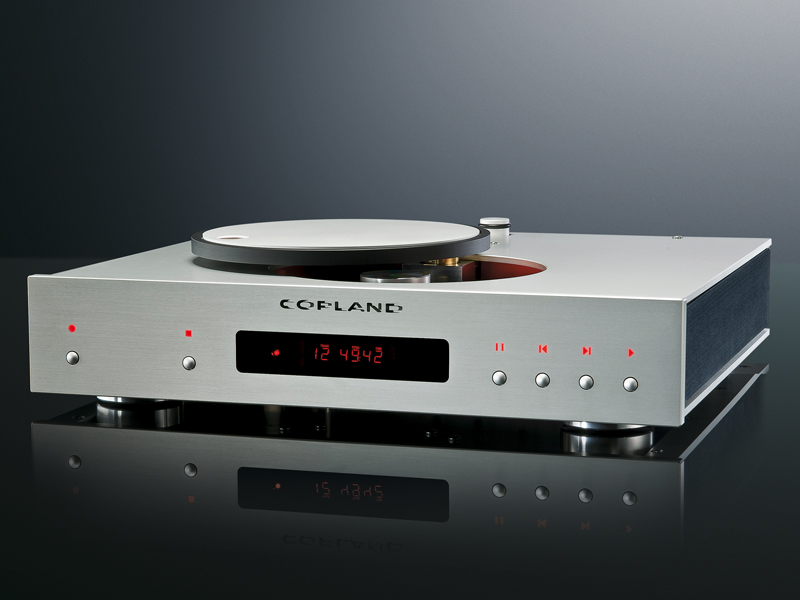TechRadar Verdict
This is a sophisticated and highly revealing player that avoids the usual pitfalls of its kind in order to deliver music in a remarkably realistic and engaging form. It also looks great too
Pros
- +
Uncanny lack of grain
- +
Great subtlety and resolution
- +
Could easily turn you into a bass junkie
Cons
- -
Not as lavishly built as some
- -
Two second lag is a little odd, but these are minor quibbles
Why you can trust TechRadar
For its CDA825 CD player, Copland has gone back to the drawing board and come up with a totally fresh machine, one that is top-loading and incorporates a new type of filter utilising psycho-acoustic findings as the basis for its operation.
Its styling is classic Scandinavian cool with absolutely no clutter nor inscriptions, save for the laser-cut lettering. This, combined with the circular top cover, makes it the best bit of design I've seen in ages.
But then Copland has a reputation for making high-quality, competitively priced audio electronics that often use valves alongside transistors. So when it brings a new CD player like the CDA825 to the market, we're always interested.
Unfortunately, that doesn't happen very often: the last time was five years ago and it cost less than half as much as its replacement. That model, the Hi-Fi Choice award winning CDA823, was a dynamic and involving machine and a tough act to follow.
Remake, remodel
Copland has not just put the building blocks of the CDA823 into a more contemporary case, it has totally redesigned the player from the ground up. There are some similarities however.
One is the use of buffering in between the output of the transport and the DACs. Most players stream direct from the disc drive to the converter, but copland has isolated these elements with a two-second buffer, the purpose being to eliminate timing errors or jitter in the bitstream. By using a solid state buffer and re-clocking the data as it is sent out, the DAC is fed a signal that has no timing errors.
The top-loading transport was selected because in copland managing director Olé Möller's words "I find top-loading CD players to be the most sexy-looking CD-playing machinery."
Conveniently the Philips CDPro2LF mechanism he chose for the player was developed with this type of operation in mind: it sits under a large round lid that opens sideways on a chunky brass bearing and needs to be removed in transit.
The transport mechanism itself is suspended on springs which rest on brass bearings. It doesn't move a great deal when you press it, but there is clearly some compliance there and must help keep resonance at bay.

The chassis itself has been optimised to isolate the player from the low-frequency vibrations produced by loudspeakers. Tap the top and it doesn't seem all that solid, but this is because the damping system isn't designed for high-frequency resonance and doesn't use rubber or plastic. Instead, it has carefully placed fixings – you can see all six top-plate bolts – which tune out the sort of resonances it has to deal with in real life.
One surprise on the CDA825's spec list is the suggestion that a lot of players don't use full error correction because they aren't always implemented by chip manufacturers. Apparently cost considerations lead to decoder chip sets being used that do not include some key elements of error correction required for red-book CD replay.
On the digital to analogue conversion front, copland has used Wolfson's well-regarded WM8741 24-bit/192khz converter chips with two in each channel. This dual-differential approach produces a balanced output that is designed to eliminate noise. It's a tried and tested route in high-end digital sources that offers a benefit, whether you use the single-ended or balanced outputs.
The analogue output stage is devoid of op-amps, employing instead a total of nearly 300 components in a discrete dual-differential construction – unlike some of Copland's amplifiers, there are no valves in this player.

Going against the growing trend for offering digital inputs like USB on modern players, Copland has produced a dedicated CD spinner with only outputs, analogue and digital. It is therefore as committed to its task as the clarity of casework design would suggest and you have to wonder whether those into PC audio would be in the market for a player at this price.
Cutting edge
Our CDA825 is a pre-production example and therefore not entirely representative. That said only the back panel doesn't look like the finished article. It's cutting edge in terms of industrial design, the way that the silver top and bottom plates sandwich black side panels is a very nice touch and I'd challenge anyone to come up with a cleaner bit of fascia design.
The way that the button functions are described by backlit symbols is extremely well executed. The slight lack of solidity in the top panel may be down to the non-production nature of this sample, but it's not all that encouraging despite the logic of its approach when it comes to resonance control – you want a product that feels as good as it looks at this price.
The circular lid is very neatly executed and the swing action rather sexy and I like the way that in order to prepare it for transit you need to remove the knob at the rear so that the lid swings round 180 degrees and then lifts out. The gap between lid and case on our sample seemed a little high, apparently it will be two millimetres in production which would look better.
The remote handset is also very nicely designed and executed, it looks generic but that could be because ours isn't yet badged. It has an alloy front with a rubberised back and is ergonomic and tactile, something that's surprisingly rare with more expensive handsets.
In value terms there is some pretty stiff competition on the build front, Esoteric is one of the strongest in this department and its X-05 feels like a rather more expensive machine and one that also plays SACD for that matter. Naim's CDX2 CD player is a little less expensive (£3,325), but offers the company's high-build quality and enviable residual value.
Making an understatement
Understated in appearance and sound, this is a remarkably neutral and undemonstrative machine. Yet it becomes apparent after a few tracks that it has a hard to define appeal that stops you from pressing the next track button, let alone stop or pause.
A few more tracks and I realise that the appeal lies in what is absent rather than present, namely that this CD player doesn't exhibit grain or glare, something that the vast majority of digital sources produce when you play piano or female vocals. This is some revelation and I can't help thinking that it has something to do with the apodising filter that set out to eliminate a flaw in digital systems that has not been tackled before.
Whatever it is, it works like a dream and I stop thinking why doesn't this player sound super transparent and turn my attention to how I can get the system to be more revealing.
One question is why did PMC have to take back its FACT 8 speakers? Their incredible openness would have revelled in the calmness of presentation from the Copland.
The transparency is, to an extent, a factor of warm-up: two or three hours are not enough and a weekend later there is no shortage of resolution on offer. The player doesn't have a bright, super clean sound but it reveals an awful lot of harmonic detail right across the band – it's more of an analogue balance in fact.
Not warm or in any way smoothed off in the mid or treble but devoid of digital crispness, in practice this means that small bells have a pure, shiny ring to them and bass drums have weight and power while the midband lets you hear right into the mix.
With a great recording such as Tord Gustavsen's The Ground, this means that the speakers disappear and let the musicians or their sound inhabit the room in a very solid fashion. It brings out the shimmer of the cymbals, the woody resonance of the double bass and the body and mass of the piano to spectacular effect. In fact, I don't recall hearing this sound being so evocative of the live event. If only more discs were recorded this well.
One louder
Conveniently, even the less spectacular discs don't disappoint, they may not offer the same degree of realism but they have more going on in the mix than is usually apparent. Thanks to the aforementioned lack of grain you can play louder too, so the quality of musicianship is even more entrancing.
Inevitably, the copland is unable to filter out distortion in the recording and this comes through with the music. A CD-R of the Portico Quartet's Isla just doesn't cut-it – the real thing must be acquired.

Keith Jarrett's recent Testament disc is considerably more gratifying, the solidity of the piano and the stage it's sitting on is palpable thanks to the Copland's extraordinary control and speed in the bass. It doesn't seem like a fast player in the manner of a Rega or Naim but the bass is extremely well defined, yet delivered in a totally effortless fashion. There's no undue emphasis of leading edges, which is not something you often encounter in audio sources of any persuasion.
It's not as open, nor as tonally rich as the AMR CD-777, but it does have a more even balance and is more revealing at low levels. In the long term these qualities will make it a more engaging and exciting player to use, because you can hear more of the music and less of the hardware.
It's not as revealing as Moon's 750D (at twice the price), but has a slightly greater ability to engage your heart, mind and gut, especially if the latter enjoys killer bass. Even at sensible levels the bass has a weight and solidity that is thrilling. You may not be a bass head now, but once you discover what's lurking on your favourite discs I guarantee that you will be in future.
A thrilling experience
The CDA825 continues Copland's line of fine CD players. It's expensive, compared with its predecessor, but its sound and design are entirely in line with that price. In character it's not unlike an SME turntable: it doesn't seem particularly transparent, yet you can hear nearly everything about the recordings it plays.
At the same time as informing your head, this Copland lets the music play with your heart and it's a thrilling experience. The last time I encountered that sensation was with an £18,000 two-box CMM Labs, which puts things in context.
Don't buy this expecting an instant hit that will fade over time, buy it to find out just how beautiful, powerful and enthralling your music collection is. You don't need a better reason than that.
Follow TechRadar Reviews on Twitter: http://twitter.com/techradarreview
